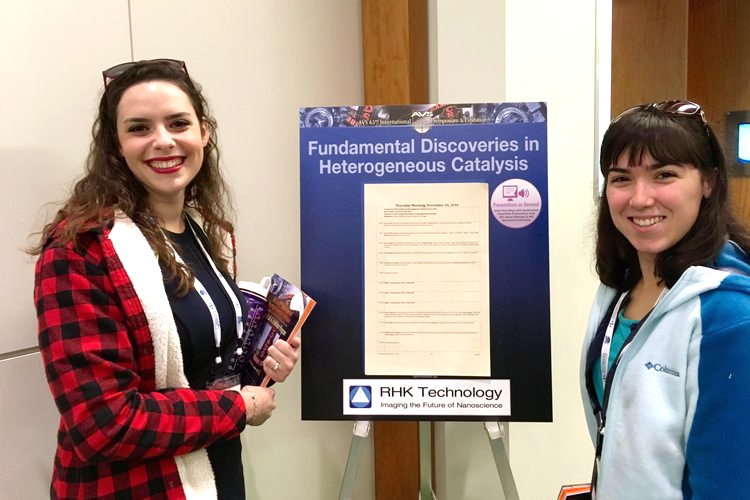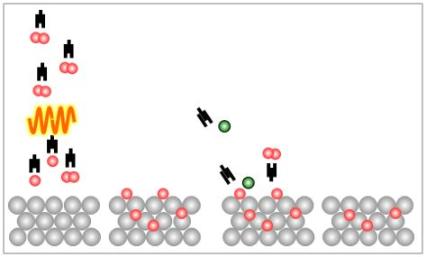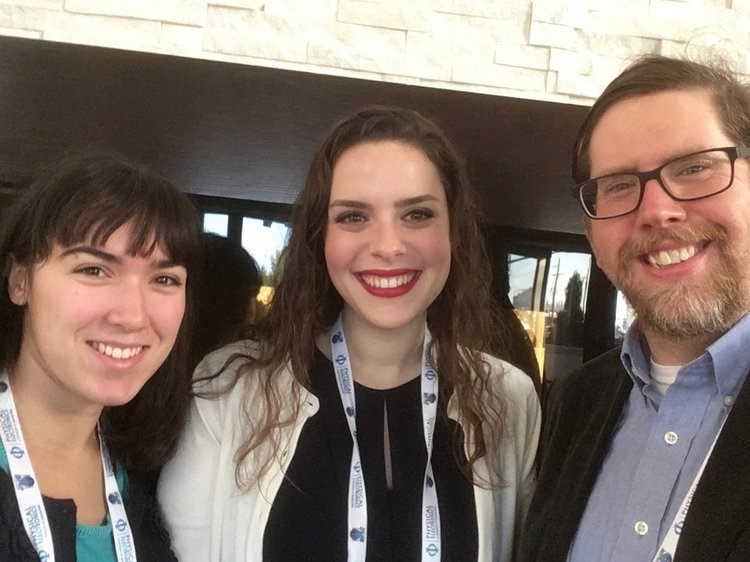home_news
Graduate Student Feature: Marie Turano's Conference Experience

First-year graduate student, Marie Turano (right), attends the AVS International Conference with fellow chemist, Rachael Farber.
This past winter, as temperatures began to drop in Chicago, the Killelea Research Group readied themselves for a trip to a warmer city—Nashville, TN. They were to attend the American Vacuum Society’s 63rd International Symposium—a week-long conference drawing faculty, graduate students, and other researchers from around the world to discuss advancements in vacuum science. First year graduate student, Marie Turano, takes us through the trip and experience of attending the conference, as well as describing the research that led her there.
For starters, what exactly is vacuum science? Specifically, ultra-high vacuum?
“In our group, we work under ultra-high vacuum conditions; reactions occurring under very low pressures”, explains Marie, “those which occur at a pressure of 1x10-10 Torr. We study metal surfaces under low pressures to mimic the conditions of catalysis, so that we can unravel the reaction mechanisms occurring on the metal/reaction interface”.
At the conference, Marie presented a poster on the process of “cleaning” the surface of a rhodium crystal—Rh(111). The procedure entails dosing the crystal with oxygen, so the crystal surface is completely covered with oxygen. When enough oxygen has reacted with the surface, the excess oxygen can migrate into the subsurface of the crystal. Then, using biased Argon (Ar) ions to gently knock the oxygen atoms off the top layer of the crystal, the surface is cleaned. The result is a Rh(111) crystal that is now “clean” of any surface atoms, permitting the group to study the properties of the oxygen beneath the surface. According to Marie, this is when you can begin to ask the bigger questions, such as: does subsurface oxygen play a role in reactions? If so, what is its role? And, how does the presence of subsurface oxygen influence what’s going on in the surface?
The end goal of the project is to characterize the properties of the subsurface oxygen.

What about “big picture”? In the end, what…?
Marie nods, understanding the question before it is fully asked, “whenever people ask me about my research and what we study, I say, ‘it’s studying reactions similar to those occurring in the catalytic converter in your car’. We are investigating a related process by studying a catalytically active metal, its properties, and then trying to answer fundamental questions relevant to heterogeneous catalysis.”
Although the experiments that Marie and the rest of the Killelea Research Group conduct may seem very specialized, there is actually a variety of research that occurs in the field of vacuum science.
What is one to expect from an international conference all about vacuum science?
“I wish I’d brought the program for you,” she says eagerly, as she opens and closes her hands like a book, “it was page, after page, after page of talks. It was great to see how others’ research relates to what we do. It amazed me how so many people can be researching the same area, but not quite the exact same topic.” For example, while the Killelea Group focuses their studies on molecules on the Rhodium surface, another group may be presenting their findings of a surface analysis of Nickel. The materials, methods, and instrumentation vary from group to group. Everyone has their own unique take. A lot of the same questions are being addressed, but the research presented tackles them from different angles.
The research complements each other, and suddenly the field can become very broad.
There is great benefit in attending conferences such as this one. In listening to other’s presentations, you can find common ground with other research groups, but more importantly, you get to build connections, gather new information, and find new ways to circumvent a problem you’ve been running into.

To learn more about research conducted by the Killelea Group, go here.
The 64th AVS International Symposium will be hosted in Tampa, FL, Oct 29-Nov 3, 2017.


